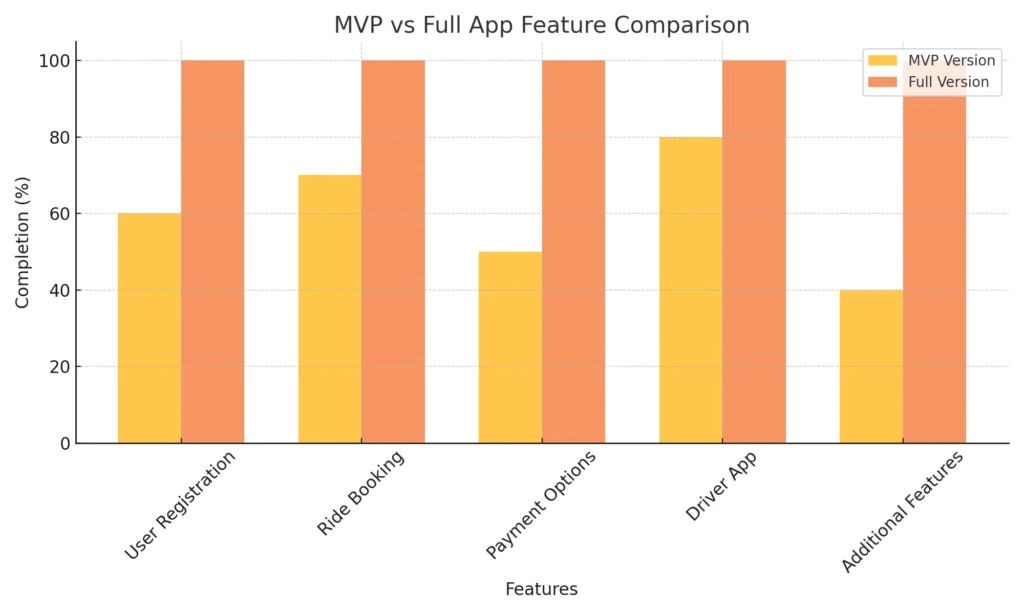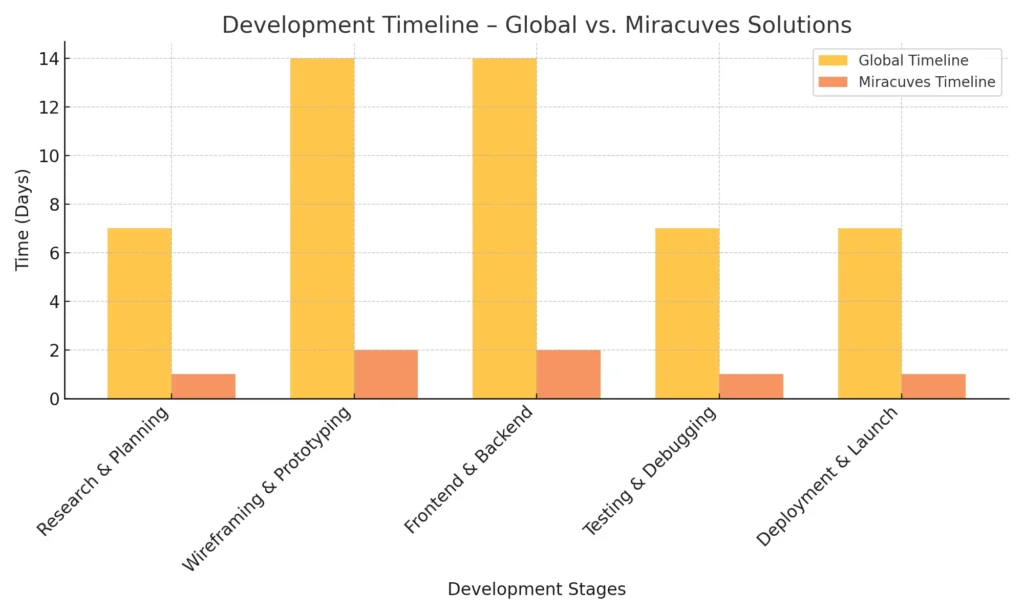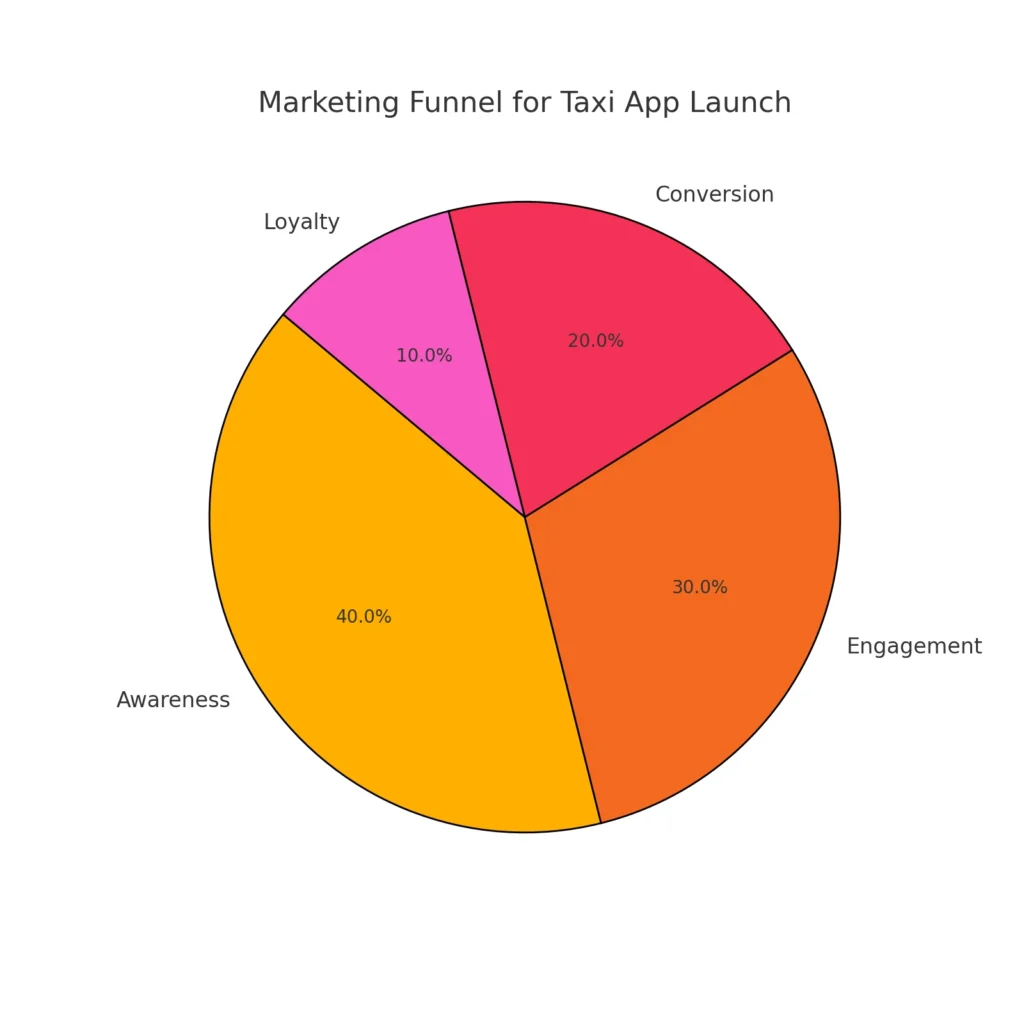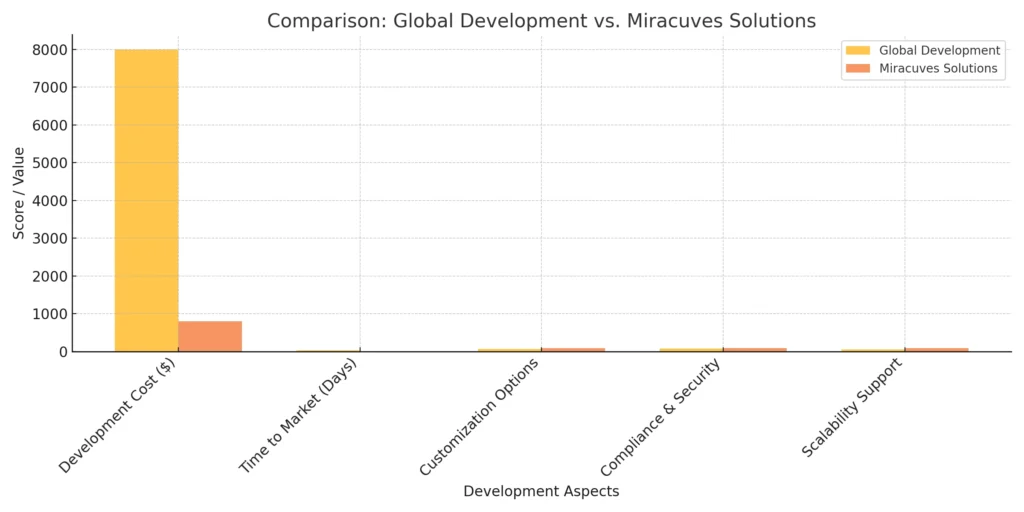The transportation landscape has evolved dramatically in recent years, with apps like Ola revolutionizing urban travel. A taxi booking system offers users the convenience of hailing rides instantly, scheduling trips, or even opting for carpooling, all from the comfort of their smartphones. With the demand for on-demand transport solutions growing rapidly, entrepreneurs and developers are increasingly exploring opportunities to build Ola alternatives.
This guide walks you through the process of creating a taxi booking system from scratch. Whether you’re a startup seeking to launch a ride-hailing app or an established business looking to enter the urban mobility market, the strategies covered here will give you an edge. From technical requirements to cost estimation, we’ll leave no stone unturned.
If you want to develop a competitive app faster and more affordably, Les solutions Miracuves can be your perfect partner. Known for its ready-made solutions and rapid development process, Miracuves can deliver complex apps in just one day, at 10% du coût global. This makes it an ideal choice for anyone looking to enter the ride-hailing space quickly and efficiently.
Qu'est-ce que l'application et à quoi sert-elle ?
UN taxi booking system like Ola provides a seamless platform for passengers and drivers to connect. It involves two essential components: the customer app et le application pilote. The goal is to simplify urban travel by offering fast and reliable rides through an easy-to-use mobile application.
- Fonctionnalités de l'application client:
The customer can book a taxi with a few taps, select the ride type (bike, car, or shared), and track the vehicle in real-time. In-app payment options like credit/debit cards, digital wallets, or cash offer users flexibility. Customers can also schedule rides in advance, leave feedback, and view fare estimations before confirming the ride. - Fonctionnalités de l'application Driver:
On the driver’s side, the app provides tools for accepting or rejecting rides, navigation assistance, and performance tracking (such as earnings history and customer ratings). The driver app ensures drivers can maximize earnings with minimal hassle through smart algorithms that assign the most relevant rides.
This platform extends beyond typical cab services, offering shared rides (carpooling) and partnerships with businesses for corporate travel. With built-in features for safety, such as emergency alerts and driver verification, these apps ensure a secure travel experience for passengers.
By efficiently connecting users with available drivers, taxi booking apps reduce wait times and make urban transportation more sustainable. They serve as a vital component of smart cities, improving access to reliable, cost-effective transportation for users.
A lire aussi :- Building Scalable Taxi Platforms
| Fonctionnalité | Customer App | Application pour conducteur |
|---|---|---|
| Réservation | Instant and scheduled rides | Accept or reject rides |
| Tracking | Real-time vehicle tracking | Navigation tools |
| Options de paiement | Wallets, Cards, Cash | In-app earning reports |
| Feedback System | Rate and review rides | Performance insights |
| Ride Type Selection | Bike, Car, Carpooling | Multiple ride options |
Pourquoi créer cette application ?
La demande de on-demand transport solutions is skyrocketing as cities grow more congested, and people seek faster, more convenient travel options. Building a taxi booking system like Ola provides a great opportunity for entrepreneurs to tap into the urban mobility market. Here’s why this is a profitable venture:
- Rising Market Demand:
More people are turning to ride-hailing services for their daily commutes. Whether it’s getting to work, meeting friends, or running errands, urban dwellers rely heavily on these platforms. The post-pandemic era has also seen a rise in demand for carpooling and contactless payment options, creating space for innovation. - Niche Opportunities:
Launching an alternative to Ola allows you to serve unaddressed segments. This could include smaller cities, eco-friendly transport (like electric vehicles), or specialized services like female-only rides. Identifying such gaps in the market gives your app a competitive advantage. - Flexible Business Models:
Building a ride-hailing app opens doors to multiple revenue streams. You can earn through ride commissions, ad placements, corporate partnerships, and carpooling fees. Unlike traditional taxi services, the digital platform allows for automated bookings and smoother operations, reducing overhead costs. - Affordable Development with Miracuves Solutions:
Effet de levier Miracuves Solutions’ ready-made solutions and rapid development, you can enter the market 30 fois plus rapide at just 10% of the global cost. This gives you a head start and lowers the financial risk, making it more viable to build an Ola competitor.
How to Differentiate from Competitors
In a competitive market dominated by players like Ola, Uber, and others, building a successful ride-hailing app requires more than just replicating existing features. To stand out, your app needs a blend of innovative ideas, personalized offerings, and efficient operations. Here are some strategies to differentiate your taxi booking app:
1. Introduce Green Rides
- Offre options de transport écologiques like electric vehicles (EVs) appeals to environmentally conscious users.
- Partnering with EV rental companies can help offset fuel costs and attract government subsidies.
2. Local Market Adaptation
- Tailor services for under-served cities or rural areas, where global ride-hailing giants may not have a strong presence.
- Fournir support multilingue to make the app user-friendly across different regions.
3. Subscription and Loyalty Programs
- Mettre en œuvre ride subscription models (e.g., monthly passes with unlimited rides).
- Offre rewards programs to incentivize frequent riders with discounts or cashbacks.
4. Safety and Customer Trust
- Se concentrer sur fonctionnalités de sécurité avancées such as real-time ride monitoring, SOS buttons, and driver background checks.
- Highlight exclusive safety features, like rides restricted to female drivers for female passengers.
5. Improve Driver Support and Earnings
- Introduire flexible payment options (daily or weekly payouts) for drivers to ensure steady income.
- Fournir driver support programs, including health benefits and performance bonuses, to reduce churn.
| Caractéristiques | Ola | Your App (Example) |
|---|---|---|
| Options écologiques | Limited EV options | Full EV fleet available |
| Local Language Support | Major cities only | Available in regional markets |
| Modèles d'abonnement | Non | Monthly ride pass available |
| Safety Features | Standard | Enhanced with ride monitoring |
| Driver Incentives | Basic incentives | Flexible payments and bonuses |
Taille du marché et croissance de l'industrie
Le ride-hailing industry is growing rapidly, driven by urbanization, increasing smartphone adoption, and shifting consumer preferences toward convenient, on-demand services. With major players like Ola and Uber expanding aggressively, the market presents huge opportunities for new entrants offering niche solutions.
Global Market Insights
- The global ride-hailing market was valued at approximately $115 billion in 2023, and it is expected to reach $140 billion by 2024.
- Asia-Pacific remains the largest market, with countries like Inde leading the way due to dense urban populations and growing demand for affordable mobility solutions.
- Carpooling services are on the rise as cities aim to reduce traffic congestion and carbon emissions, opening new revenue streams for ride-hailing platforms.
Tendances émergentes
- Electric Vehicles (EVs): Many governments are incentivizing EVs, which is driving companies to adopt eco-friendly fleets.
- Subscription and Corporate Plans: Businesses are now turning to ride-hailing platforms for employee travel solutions, creating opportunities for corporate partnerships.
- IA et analyse de données: Ride-hailing apps are increasingly using AI-based algorithms to predict user demand, optimize routes, and improve user experience.
Regional Expansion Opportunities
- Tier-2 and Tier-3 cities in India, Southeast Asia, and Africa present untapped opportunities, with fewer competitors operating in these areas.
- Offre localized features like regional languages and cash payments makes the service more accessible to a wider audience.
A lire aussi :- Understanding Business Models of Ride-Hailing Giants
Principales caractéristiques de l'application
Pour construire une entreprise réussie Ola alternative, your taxi booking app must incorporate essential features that ensure a smooth user experience for both passengers and drivers. Below is a breakdown of the key functionalities for both the Customer App et le Application pour conducteur, along with optional features to differentiate your app.
Essential Features for Customer App
- User Registration & Login: Easy sign-up using phone numbers, social accounts, or email.
- Real-time Booking & Tracking: Book rides instantly and track the driver’s location on the map.
- Plusieurs options de paiement: Include wallets, credit/debit cards, and cash payments for convenience.
- Fare Estimation: Let users see the fare before confirming the ride.
- Rating & Feedback System: Allow customers to review their experience and rate drivers.
Essential Features for Driver App
- Driver Registration & Verification: Ensure drivers undergo a verification process.
- Accept/Reject Ride Requests: Drivers can choose rides based on their availability.
- In-app Navigation: Integrated maps for route optimization.
- Tableau de bord des revenus: Track daily and weekly income.
- Performance Analytics: Receive feedback to improve service quality.
Optional Features to Stand Out
- Carpooling: Provide users with the option to share rides, reducing costs and emissions.
- Corporate Accounts: Offer subscription plans for companies to manage employee travel.
- SOS Button for Safety: Emergency feature to contact help during unforeseen situations.
- In-app Chat: Enable direct communication between drivers and customers.
| Caractéristiques | Customer App | Application pour conducteur |
|---|---|---|
| Inscription | Social login or phone number | Driver ID verification |
| Booking System | Instant and scheduled rides | Accept or reject rides |
| Navigation | Real-time tracking | In-app maps |
| Paiements | Cards, wallets, and cash | Earnings tracking |
| Retour | Ratings and reviews | Performance insights |
MVP (Minimum Viable Product) and Development Approach
Lancement d'un Produit minimum viable (PMV) is the smartest way to enter the market. An MVP focuses only on the Caractéristiques principales necessary to operate your taxi booking system, allowing you to test market demand and collect user feedback before expanding with additional features. This strategy saves time, cost, and effort, ensuring a smooth launch while setting the foundation for future growth.
Core Features to Include in the MVP
- User Registration & Login
- Enable simple sign-ups using phone numbers or social media.
- Ride Booking System
- Allow users to book rides instantly with real-time tracking.
- Fare Estimation & Payments
- Provide upfront fare visibility and offer multiple payment options (wallets, cards, or cash).
- Driver App Integration
- Ensure basic driver functions, such as accepting/rejecting rides and navigation tools.
- Feedback System
- Include a rating system to ensure both drivers and passengers provide feedback.
Why Choose an MVP Approach?
- Mise sur le marché plus rapide: Launching an MVP ensures you enter the market quickly, gaining an early foothold.
- Reduced Development Cost: Focus on only the essential features to minimize initial investment.
- Risk Mitigation: Identify market reception and refine your product based on real user feedback.
- Évolutivité: Once your MVP is successful, you can expand features gradually, such as carpooling or subscription plans.

Exigences techniques
Building a taxi booking system like Ola requires a solid technology stack to ensure a smooth and reliable user experience. The right combination of frontend, backend, APIs, and database management tools will ensure the app runs efficiently, scales smoothly, and handles high traffic without lag. Below are the key components and tools required for both the customer and driver apps.
1. Frontend Technologies
- React Native / Flutter: For building a cross-platform app (iOS and Android) using a single codebase.
- HTML5, CSS, and JavaScript: If you plan to offer a web interface for customers or driver management.
2. Backend Technologies
- Node.js / Django: Popular backend frameworks that ensure fast performance and handle concurrent requests effectively.
- Express.js: Used with Node.js for building robust APIs.
- Base de feu: Ideal for real-time data synchronization, such as ride tracking.
3. Database Management
- MySQL / PostgreSQL: Relational databases to store user, driver, and ride details securely.
- MongoDB: NoSQL database option for handling unstructured data and fast data retrieval.
4. APIs and Third-Party Integrations
- API Google Maps: For navigation and real-time tracking.
- Payment Gateway APIs: Integrate Stripe, PayPal, or Razorpay for seamless in-app payments.
- SMS Gateway and Push Notifications: Send booking confirmations and ride alerts to users.
5. Infrastructure cloud
- AWS / Microsoft Azure: For hosting the app and managing traffic efficiently.
- CDN (Réseau de diffusion de contenu): Ensures fast loading times for all users, regardless of location.
Intégration API Google Maps ensures accurate navigation and real-time tracking for both customers and drivers. Using Google’s robust location services will enhance the user experience by providing reliable routes and estimated arrival times.
A lire aussi :- How to Build Apps for Niche Markets
| Composant | Global Stack | Miracuves Solutions Supported Stack |
|---|---|---|
| L'extrémité avant | React Native, Flutter | React Native, Flutter |
| Arrière-plan | Node.js, Django | Node.js, Django |
| Base de données | MySQL, MongoDB | MySQL, MongoDB |
| Navigation API | Google Maps | Google Maps, OpenStreetMap |
| Passerelle de paiement | Stripe, Razorpay | Stripe, PayPal, Razorpay |
| Infrastructures Cloud | AWS, Azure | AWS, Azure |
Conception et interface utilisateur (UI/UX)
The success of any ride-hailing app hinges on its conception et expérience utilisateur. A well-designed interface ensures that users—whether passengers or drivers—can easily navigate through the app, book rides, track locations, and manage payments without frustration. A seamless, intuitive user interface (UI) not only improves satisfaction but also encourages customer retention and positive reviews.
Key Design Elements for Taxi Booking Apps
- Minimalist Interface
- Utilisez un clean and clutter-free design for both the customer and driver apps.
- Simple navigation with easy access to key features like ride booking et tracking.
- Personalized User Experience (UX)
- Mettre en œuvre dynamic suggestions based on ride history and preferences (e.g., “Your usual route to work”).
- Utiliser options de mode clair et sombre to appeal to different user preferences.
- Fast-Loading Screens
- Ensure that the app loads quickly, as users expect real-time interactions sans délais.
- Optimize for lower internet bandwidths, especially in regional or rural areas.
- Visual Aesthetics with Functionality
- Intégrer interactive maps for live tracking using APIs like Google Maps.
- Use visually appealing icons and animations to enhance usability (e.g., car icon moving on the map).
- Consistency Across Platforms
- Maintain design uniformity across Android, iOS, and web interfaces.
- Effet de levier React Native ou Flutter to ensure consistent design elements across platforms.
- Driver-Friendly Interface
- Fournir un straightforward dashboard showing rides, earnings, and customer ratings.
- Mettre en œuvre color-coded indicators for ride status (e.g., green for available, red for busy).
| Design Features | Customer App | Application pour conducteur |
|---|---|---|
| Theme Options | Light and dark mode | Dark mode preferred |
| Map Integration | Real-time ride tracking | Route optimization tools |
| Ride History | Easy access to past bookings | Earnings and ride records |
| Notifications | Booking and payment alerts | Ride requests in real-time |
| Tableau de bord | User profile and payment setup | Daily earnings overview |
Processus de développement
Creating a taxi booking system from scratch requires a structured and strategic development approach. Breaking the process into well-defined stages helps ensure a smooth workflow, minimizes risks, and allows for faster deployment. Below is a step-by-step guide to the processus de développement, with insights on how Miracuves Solutions’ rapid development gives you an edge.
1. Recherche et planification
- Identify target markets and define the Caractéristiques principales for your MVP.
- Conduire analyse concurrentielle to pinpoint gaps in existing ride-hailing apps.
- Outline your modèle d'affaires (commissions, subscriptions, or corporate plans).
2. Wireframing et prototypage
- Créer low-fidelity wireframes to map out the app’s user flow.
- Use tools like Figma ou Adobe XD to develop interactive prototypes.
- Focus on keeping the design simple, ensuring an intuitive user experience.
3. Développement front-end et back-end
- Développement Front-End: Utiliser React Native ou Battement to build cross-platform apps.
- Développement du backend: Set up Node.js ou Django to handle user data and ride requests.
- Implement APIs for real-time tracking, payment gateways, and notifications.
4. Testing and Debugging
- Conduire unit tests and integration tests to ensure all app components work seamlessly.
- Test the app on multiple devices and platforms to identify and resolve bugs.
- Utiliser test bêta to gather feedback from early users and drivers.
5. Déploiement et lancement
- Déployer l'application sur Google Play Store et Apple App Store for public access.
- Utiliser CDN (Réseau de diffusion de contenu) services to ensure fast performance.
- Dérouler incremental updates based on user feedback and performance analytics.
How Miracuves Solutions Accelerates Development
Avec des solutions prêtes à l'emploi and built-in integrations, Les solutions Miracuves reduces the typical development time from one month to just one day. This rapid deployment allows you to launch the app quickly and focus on capturing market share.

Estimation des coûts et délais
One of the biggest challenges in developing a ride-hailing platform is balancing cost and time. Traditional development methods can take weeks or months and cost thousands of dollars. However, with efficient solutions like Miracuves Solutions, you can drastically reduce both. Here’s a detailed breakdown of what you can expect in terms of cost and time.
1. Global Cost and Timeline Estimates
- Basic App Development:
- Coût: Around $6 000 à $10 000
- Temps: 1 to 2 months
- Advanced App with Custom Features:
- Coût: $20,000 or more
- Temps: Up to 6 months
These numbers include the expenses for design, frontend and backend development, testing, et déploiement. Additionally, hidden costs like maintenance and updates can further increase the total budget.
2. Miracuves Solutions Cost and Time Advantage
- Coût: Only 10% du prix mondial
- Example: If the global cost is $6,000, Les solutions Miracuves delivers the same product for just $600.
- Temps: 1-day delivery versus the global average of 1 month
- des solutions prêtes à l'emploi et ready-to-use components drastically reduce development time.
Choosing Miracuves Solutions gives businesses the chance to enter the market quickly and affordably sans compromis sur la qualité.
| Service | Global Average Cost | Coût des solutions Miracuves | Calendrier mondial | Miracuves Timeframe |
|---|---|---|---|---|
| Basic App Development | $6,000 | $600 | 1 Month | 1 Day |
| Advanced App with Features | $20,000 | $2,000 | 6 Months | 1 Week |
| Maintenance et mises à jour | $2,000 / Year | $200 / Year | Continu | Continu |
Stratégies de monétisation
Building a taxi booking system is not just about providing transportation; it’s about creating a sustainable business with multiple flux de revenus. To ensure profitability, your app should incorporate diverse stratégies de monétisation that cater to different user segments and business partners.
1. Commission-based Model
- Comment ça marche: Take a percentage from each ride completed through the platform.
- Why it Works: This model ensures a steady revenue stream as long as rides are being booked.
- Exemple: Charging a 10-20% commission on every trip from the driver’s earnings.
2. Formules d'abonnement
- Offre monthly or yearly plans for users who need regular rides, such as commuters.
- Corporate clients can use comptes d'entreprise with discounts on bulk bookings.
- This model provides predictable income and builds user loyalty.
3. In-App Advertising
- Sell ad space to local businesses or display promotions for drivers.
- Fournir publicités ciblées based on user location and behavior, creating an additional revenue stream.
4. Carpooling and Shared Rides
- Encourage users to share rides with others to reduce costs and increase vehicle efficiency.
- Charger un small fee per additional passenger, benefiting both the platform and the drivers.
5. Surge Pricing
- Mettre en œuvre tarification dynamique to increase fares during peak hours or high-demand periods.
- This model incentivizes drivers to work during busy hours while boosting revenue.
| Stratégie | Description | Avantage |
|---|---|---|
| Commission Model | Percentage from each ride | Continuous revenue stream |
| Formules d'abonnement | Monthly/yearly passes for regular users | Predictable income, user loyalty |
| Publicité intégrée à l'application | Ads based on user behavior | Additional revenue from partners |
| Carpooling Fees | Fees for shared rides | Higher vehicle efficiency |
| Tarification dynamique | Dynamic fares during high demand | Higher earnings, driver incentive |
Lancement et commercialisation de l'application
A well-planned stratégie de lancement et de marketing is essential to ensure your taxi app makes a splash in the competitive ride-hailing market. The goal is to attract early users, build brand awareness, and create momentum that ensures long-term growth. Here’s a step-by-step approach to launching and promoting your app effectively.
1. Pre-launch Activities
- Test bêta:
Release the app to a small group of users (early adopters or influencers) to identify bugs and collect feedback. This ensures the app is polished before the official launch. - Landing Page and Email Signup:
Créer un page de destination to build anticipation, gather email sign-ups, and keep potential users informed about the launch. - Social Media Teasers:
Post behind-the-scenes content and countdowns on social media platforms to generate excitement.
2. Launch Day Strategy
- Press Releases and Media Outreach:
Distribute a communiqué de presse to local media and tech blogs to announce the launch. Collaborate with influenceurs in your target market to spread the word. - Optimisation de l'App Store (ASO):
Ensure the app is well-optimized for Google Play Store et Apple App Store avec targeted keywords, engaging descriptions, and high-quality screenshots.
3. Post-launch Marketing and Growth Strategies
- Optimisation des moteurs de recherche (SEO):
Optimize your website and blog content for keywords related to taxi booking and ride-hailing (e.g., “Ola alternative,” “urban transport solution”). This drives organic traffic over time. - Social Media Ads and Campaigns:
Courir publicités ciblées on Facebook, Instagram, and Google to attract your ideal audience. Focus on retargeting campaigns to convert visitors into app users. - Programmes de référence:
Encourage users to invite friends and family with incentives like discounts or free rides for both referrer and referee.

Considérations juridiques et réglementaires
Launching a taxi booking app requires careful attention to conformité légale to avoid future complications. Every market has its own set of regulations governing ride-hailing services, which must be met to operate smoothly. Here’s an overview of the key legal and regulatory aspects to consider:
1. Licensing and Permits
- Ensure your business holds the required licenses and permits to operate legally.
- Depending on the region, you may need transport service licenses ou driver permits to run a ride-hailing platform.
2. Data Privacy and Security Compliance
- With the app handling personal user data, such as names, addresses, and payment details, compliance with data protection laws like GDPR est essentiel.
- Mettre en œuvre secure encryption protocols to protect data and prevent breaches. Include a transparent privacy policy within the app that explains how user data is collected, stored, and used.
3. Driver Contracts and Insurance
- Draft driver agreements that outline their responsibilities, commission rates, and terms of service.
- Offre couverture d'assurance to drivers, passengers, and vehicles to ensure peace of mind and protect your business from liability in case of accidents.
4. Conformité fiscale
- Assurez-vous que votre application est conforme aux local tax laws, including GST or VAT, where applicable.
- Automate invoice generation for both customers and drivers to streamline operations.
5. Safety Regulations and Passenger Rights
- Intégrer emergency features like an SOS button to meet local safety requirements.
- Assurer le respect des local labor laws, especially if offering benefits to drivers.
Ensuring Conformité au RGPD is crucial for apps handling user data, especially in regions governed by strict data protection laws. A clear privacy policy aligned with GDPR not only builds user trust but also protects your business from regulatory fines.
| Legal Aspect | Description | Importance |
|---|---|---|
| Licensing & Permits | Transport licenses and permits | Legal authority to operate |
| Conformité à la confidentialité des données | GDPR, encryption, and privacy policies | User trust and security |
| Driver Contracts & Insurance | Driver agreements and insurance coverage | Liability and service quality |
| Tax Compliance | Adherence to GST/VAT laws | Financial transparency |
| Safety Regulations | SOS button, passenger rights compliance | Public safety and reliability |
Navigating these legal requirements ensures your app remains conforme and builds trust with users and drivers. By addressing these issues from the start, you can avoid costly penalties and establish your platform as a reliable and secure service.
Croissance et évolutivité futures
Building a taxi booking app isn’t just about launching—it’s about preparing for long-term growth and evolving market demands. As your app gains traction, it must scale efficiently to accommodate new users, drivers, and services without compromising performance. Here are essential strategies to ensure your app grows sustainably and remains relevant in a competitive landscape.
1. Add New Ride Options
- Expand your offerings to include electric vehicles (EVs), auto-rickshaws, or bike taxis to appeal to diverse user preferences.
- Lancement premium rides for business travelers or economy options for cost-conscious users.
2. Introduce Subscription and Corporate Plans
- Créer monthly subscription models to attract regular commuters.
- Offre corporate packages for businesses to manage employee travel, creating a new revenue stream.
3. Expand into New Regions
- Explorer Tier-2 and Tier-3 cities where competition is lower, and ride-hailing services are in demand.
- Tailor services to each region by supporting local languages and payment methods like cash and UPI.
4. Data-Driven Optimization
- Utiliser AI and analytics tools to predict peak hours, optimize routes, and enhance customer service.
- Analyser user feedback and ride data to introduce meaningful updates and new features.
5. Plan for Seasonal Demand and Surge Capacity
- Mettre en œuvre Infrastructures en nuage to manage sudden spikes in traffic during festivals or holidays.
- Introduire prix de pointe during peak demand to balance supply and demand effectively.
| Scalability Strategy | Short-Term Impact | Long-Term Impact |
|---|---|---|
| Add New Ride Options | Attracts new users | Diversifies revenue streams |
| Formules d'abonnement | Increases user retention | Builds predictable income |
| Expansion régionale | Boosts initial market penetration | Strengthens brand presence |
| AI-Based Optimization | Improves user experience | Enhances operational efficiency |
| Infrastructures Cloud | Manages short-term traffic spikes | Prepares for future scaling |
Scalability is key to staying competitive in the ride-hailing industry. By continuously expanding features, optimizing operations with AI, and introducing new pricing models, your app can grow steadily. Proactive planning ensures that your app is prepared for future challenges and opportunities, allowing it to thrive in an ever-changing market.
Effet de levier Les solutions Miracuves ensures that your app’s infrastructure is scalable from day one, giving you the ability to add features or expand effortlessly. This enables you to focus on market growth while leaving the technical aspects to the experts.
To truly capitalize on these scalability strategies, integrating a multi-service ecosystem can provide significant advantages. UN super application approach allows businesses to offer diverse services under one platform, such as ride-hailing, food delivery, and financial services. This not only enhances user engagement but also maximizes revenue potential by catering to multiple needs within a single application. For more insights on creating a comprehensive multi-service app, explore Super App Features.
Pourquoi faire confiance aux solutions Miracuves pour votre prochain projet ?
Choosing the right partner for your app development journey is crucial to ensuring quality, speed, and cost-efficiency. Les solutions Miracuves stands out in the industry, offering the perfect blend of expertise and affordability, making it an ideal choice for building your taxi booking app.
1. 10% of the Global Development Cost
- Miracuves Solutions delivers high-quality apps at just 10% du coût moyen mondial.
- For example, a project that costs $6,000 globally is developed for only $600 with Miracuves. This pricing strategy allows startups to minimize risks and use their budget for marketing and scaling.
2. 30x Faster Development
- Avec ready-made solutions and ready-made components, Miracuves Solutions reduces development time to just one day, compared to the industry standard of one month.
- This speed ensures you can enter the market quickly and start generating revenue without delays.
3. Scalability and Customization
- Miracuves Solutions offers infrastructure évolutive so your app can grow with your business.
- Avec customization options, you can tailor your app to meet the specific needs of your target market, whether it’s corporate clients, carpooling users, or eco-conscious customers.
4. Compliance and Security
- Compliance-ready templates ensure your app meets regulatory requirements from day one.
- Miracuves Solutions also prioritizes sécurité des données by integrating encryption protocols and secure payment gateways.
5. Expérience avérée
- Miracuves Solutions has delivered numerous successful apps across industries, demonstrating its expertise in rapid app development.
- With a focus on quality and performance, you can trust that your app will meet industry standards and user expectations.

By partnering with Les solutions Miracuves, you’re not just building an app—you’re building a business-ready platform that’s affordable, fast, and scalable. This ensures that you can compete effectively in the market while keeping operational costs low and delivering exceptional value to your users.
Conclusion
Construire un taxi booking system from scratch is an exciting opportunity to tap into the booming ride-hailing market. With the right combination of core features, innovative monetization strategies, and robust technical infrastructure, your app can carve out a niche in this highly competitive industry. Focusing on user-friendly design, smart scalability options, and local market needs will ensure long-term success.
Speed and cost-efficiency are key in today’s fast-paced business landscape, and Les solutions Miracuves makes it possible to launch your app at 10% du coût global et dans one-tenth the time. Their ready-made solutions, compliance-ready solutions, and scalability features give you everything you need to build and grow your business without the typical headaches of app development.
Whether you’re targeting urban markets, expanding into regional areas, or offering unique features like carpooling or corporate travel plans, a well-executed app backed by strategic development will position you as a strong competitor in the market.
FAQ
How much does it cost to build an app like Ola?
The cost of building a taxi booking app varies. Globally, it can range from $6 000 à $10 000, but with Les solutions Miracuves, the same app can be built for just $600.
How long does it take to develop a taxi app?
Traditional development takes around one month or more. However, Les solutions Miracuves offre un one-day delivery model using ready-made solutions.
What features should I include in my MVP?
An MVP should have basic features like user registration, ride booking, payment options, driver tracking, and a feedback system to test market response efficiently.
What are the best monetization strategies for ride-hailing apps?
Popular strategies include commissions on rides, formules d'abonnement, in-app advertising, et carpooling fees. Surge pricing can also boost revenue during peak demand.
How can I make my app scalable?
To ensure scalability, build on Infrastructures en nuage and plan for feature expansion, such as corporate plans, carpooling options, et regional language support.





























































